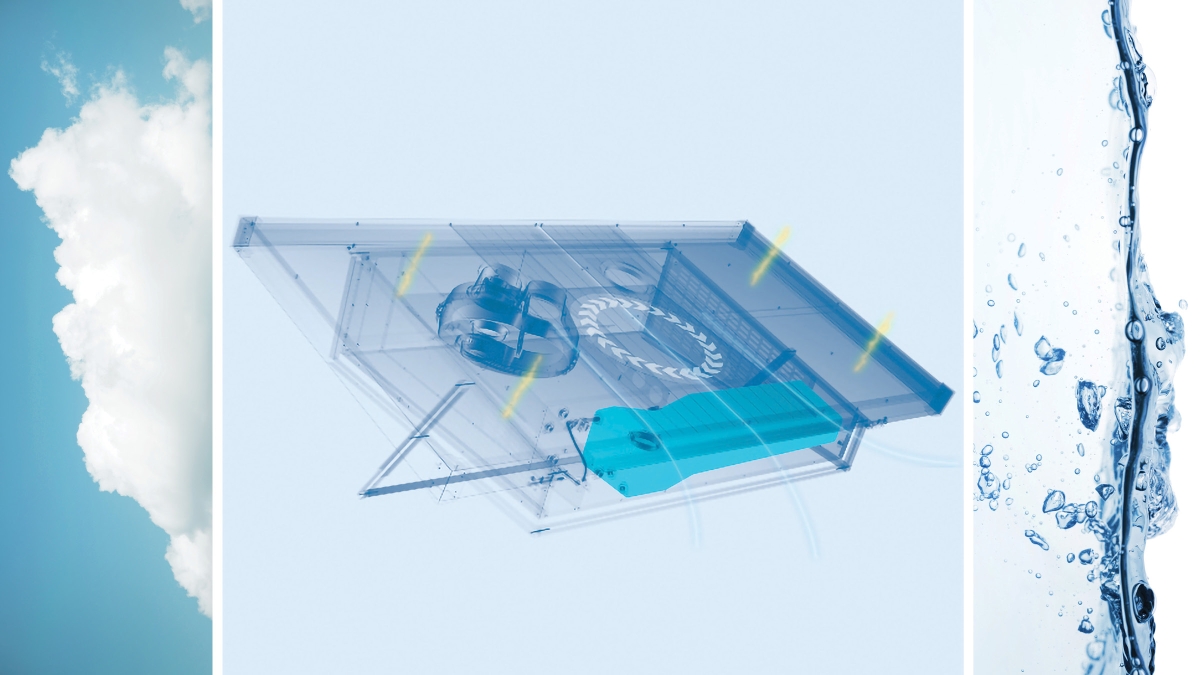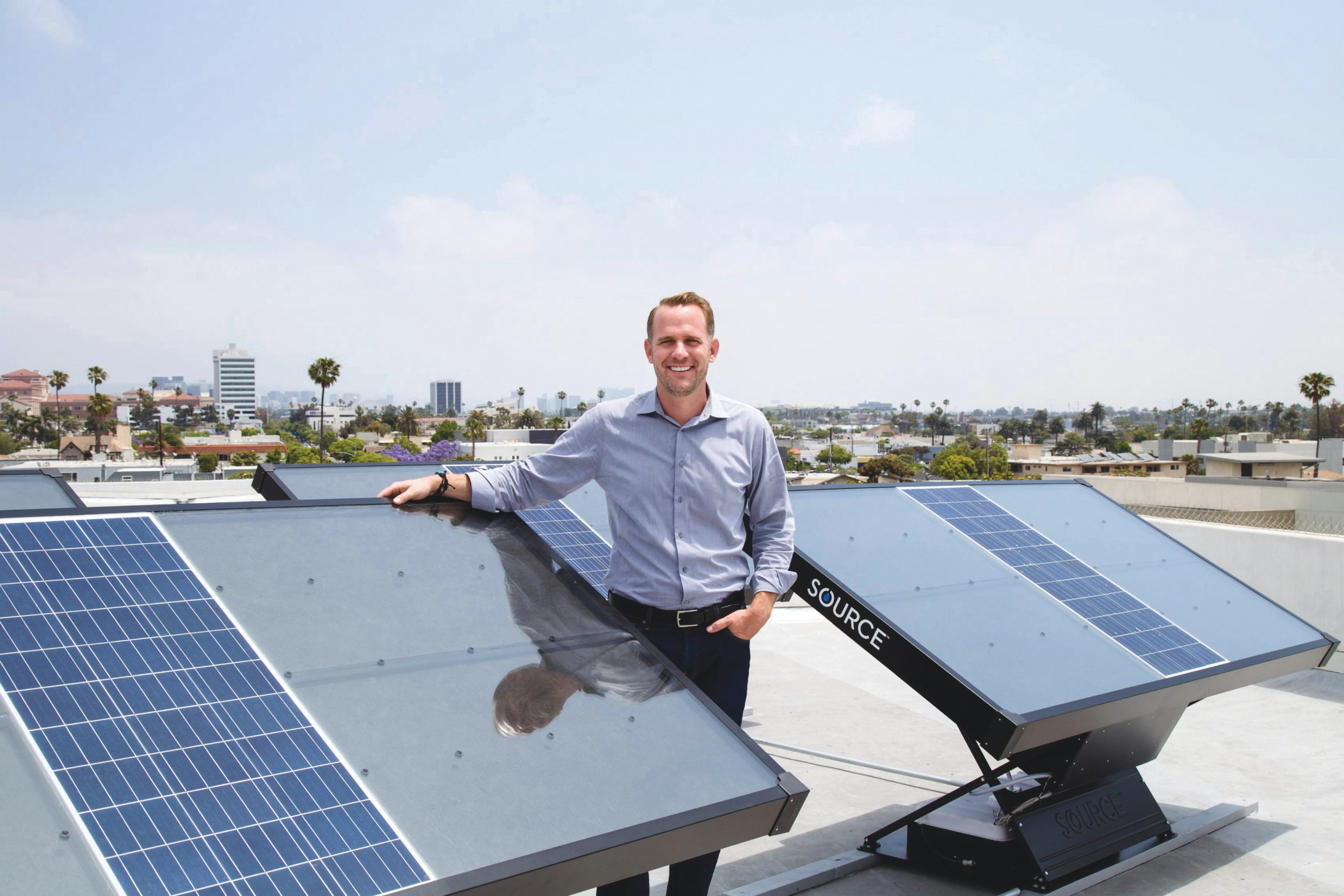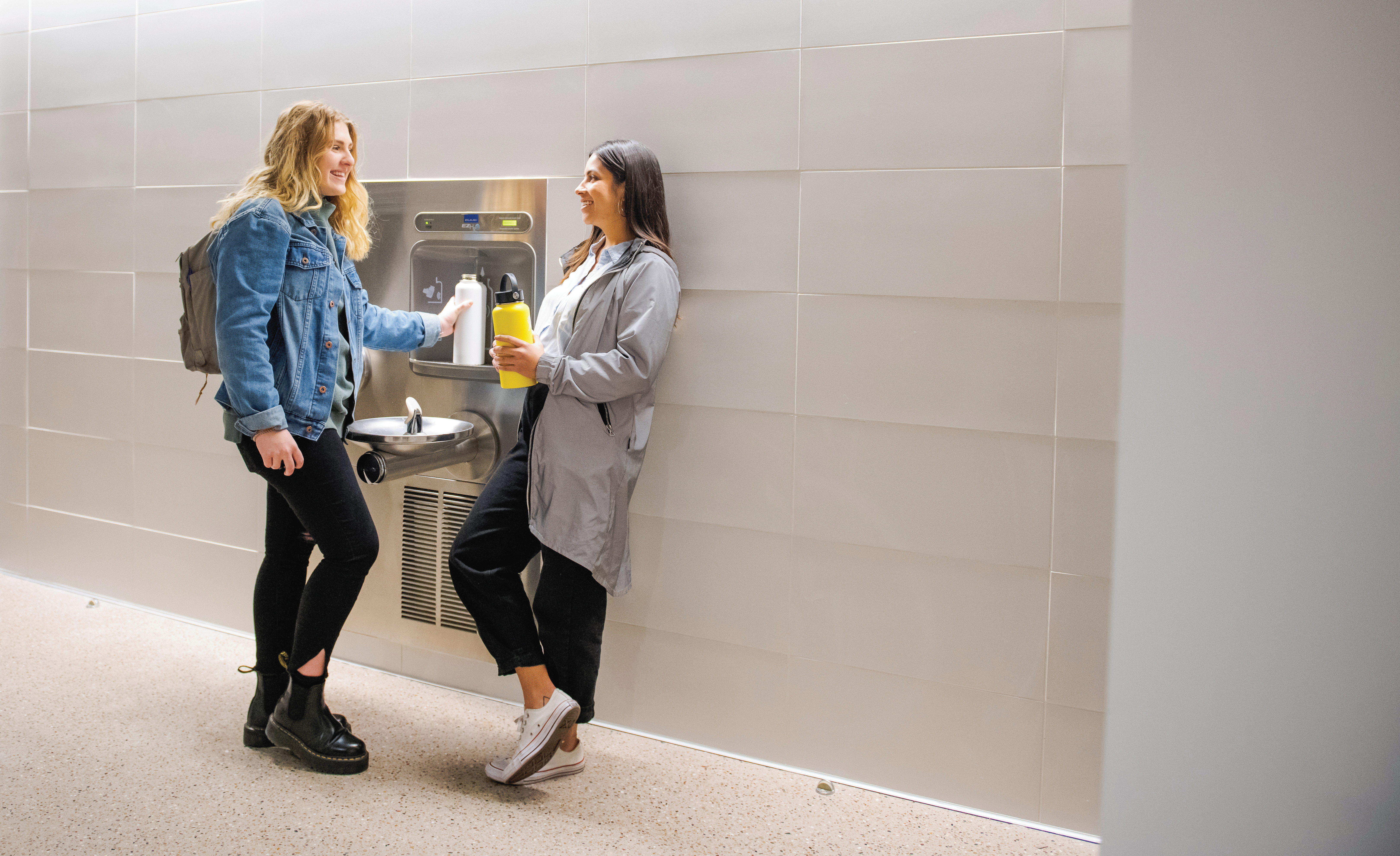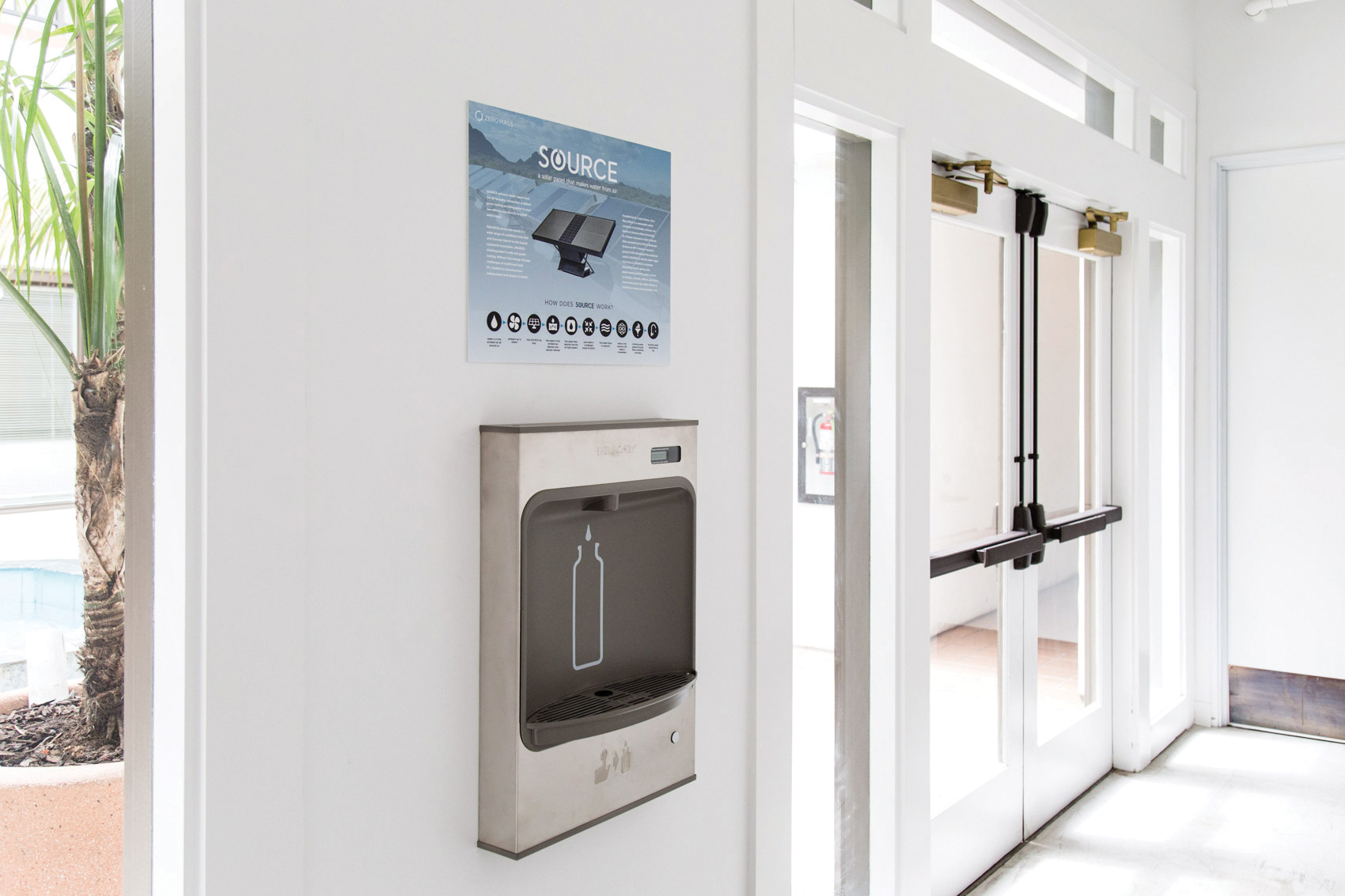The bead of an idea hit Cody Friesen as a teenager hiking mountain trails in Arizona’s sunbaked Sonoran Desert.
He grew up in the hot, arid region but near an area of lush cotton fields and citrus orchards fed by irrigation canals Native Americans built thousands of years ago.
He was keenly aware of the incongruous reality — how inhospitable that same desert can be to the landscape and wildlife within it. “Here we lived in this very water abundant area, yet, really, we’re in the middle of the desert,” he said.
A similar juxtaposition struck Friesen years later when visiting countries with abundant annual rainfall, “and yet there’s nothing to drink.”
The experiences became the engine for his award-winning technology that absorbs moisture from thin air and converts it into clean drinking water.
The founder of Scottsdale-based Zero Mass Water and an associate professor of materials science and engineering at Arizona State University, Friesen developed SOURCE Hydropanels to address one of the globe’s most pressing challenges: water scarcity.
The creation contributed to Friesen earning the 2019 $500,000 Lemelson-MIT Prize, the largest cash prize for invention in the U.S. It honors outstanding inventors who translate their ideas into technological inventions that have been adopted and bring significant value to society.
“Cody Friesen embodies what it means to be an impact inventor,” said Carol Dahl, executive director at the Lemelson Foundation. “His inventions are truly improving lives, take into account environmental considerations and have become the basis for companies that impact millions of people around the world each year.”
Friesen donated the prize to a Zero Mass Water project with Conservation International to provide Hydropanels to the Bahía Hondita community in Colombia.
“Cody’s inventive spirit, fueled by his strong desire to help improve the lives of people everywhere, is an inspiring role model for future generations,” said Michael Cima, faculty director for the Lemelson-MIT Program.
Fulton Schools Associate Professor Cody Friesen’s company Zero Mass Water now employs 91 people. Photo: Zero Mass Water
A global problem
SOURCE Hydropanels are essentially solar panels that produce water instead of electricity and require no additional power source to do it. Hydrophilic membranes inside the panels trap water vapor from air blown across them by a solar-powered fan.
The vapor-turned-water then flows through mineral cartridges, giving the water an ideal taste. Even in arid desert regions like Arizona and soggy, overcast areas like the Pacific Northwest, each Hydropanel can reliably deliver an average of 5 liters of water a day.
Five years after Friesen launched Zero Mass Water, his Hydropanels have been installed in more than 35 countries and across dozens of applications in hospitals, farms and homes — including two at Friesen’s home in Scottsdale. They provide the family of four humans and two dogs with water for drinking and cooking.
The Hydropanels also can be found in aboriginal communities in Australia and an orphanage for Syrian refugees in northern Lebanon; in desert regions in the Middle East and sub-Saharan Africa, where concerns over a global water shortage grow more intense; and someday in Flint, Michigan, where residents are still grappling with a five-year-old water crisis.
“Those are not vacation hotspots, but rather places where there’s a tremendous amount of human capacity limited by all the challenges that we know exist,” Friesen said. “So whether we’re talking about Flint, Michigan, 194 schools in Arizona with lead in their pipes, the 750 water main breaks a day across the United States, the one person who dies every 10 seconds from waterborne illness — this is a truly global problem.”
Water, the essence of life, covers more than two-thirds of the earth’s surface, but barely 3% of it is drinkable. Nearly 1.7 billion people — one-quarter of the world’s population — currently live in areas of high water stress, including Arizona, California, Colorado and New Mexico.
The United Nations projects that by 2050 more than 5 billion people could suffer water shortages due to climate change, increased demand and polluted supplies.
“The most valuable water on the planet is the water you put inside your body.” — Cody Friesen Photo: Jared Opperman/ASU
Friesen loves to talk about big solutions to these kinds of global problems. His voice grows excited as he describes the “leapfrog” technology that allows people in developing countries with access to smartphones to easily connect via the internet to the rest of the world. And about how solar energy is generating electricity in many of those areas without the need for bulky, expensive infrastructure.
“If we could do for water what solar does for electricity,” he said, “we could fundamentally shift the axis of the planet and improve the human condition with respect to water.”
‘Perfect water’ for schools
Across the U.S., SOURCE Hydropanels have been installed in schools where aging pipes have leached unsafe levels of lead into drinking water, forcing administrators to shut off water fountains. A July 2018 report from the General Accounting Office (GAO) found that 43% of schools test for lead in drinking water and 37% of those that tested showed elevated lead levels, a known neurotoxin particularly harmful to young children.
It’s a major focus for Friesen and his company. “We want to ensure that the kids have perfect water — independent of whatever their surroundings are,” he said. “And that’s been a big, big thing for us as we continue to scale the business. It’s probably one of the most impactful spaces that we operate in — education.”
In Phoenix, for example, the Pendergast Elementary School District’s partnership with Zero Mass Water is part of the district’s commitment to sustainability programs as well as expansion of a robust science, technology, engineering, art and mathematics (STEAM) curriculum.
At Copper King Elementary School, where about 10 panels were installed two years ago, students use their own reusable containers to get water from a SOURCE-fed dispenser outside the STEAM lab.
At Copper King Elementary School in Phoenix, an array of SOURCE Hydropanels delivers quality drinking water to students. Photo: Zero Mass Water
Principal Janine Ambrose says students get to see real-world engineering up close through the partnership. They get a kick knowing their water is being drawn from thin air — a new source of fascination with each new school year’s cohort of students.
“It’s definitely a learning experience for our kids here, who get to learn about and see these panels work,” Ambrose said. “We’re always looking for ways to expand the curriculum and how we can educate our kids about the environment and the sustainability of the environment, especially here in Arizona with water.”
The Hydropanels are all connected to the cloud allowing the Zero Mass Water team to monitor their performance. A typical two-panel array, which costs $4,500 including installation, will produce about 10 liters of water a day. But hundreds or even thousands of them have the capacity to supply drinking water for entire communities — much like an array of solar panels can produce enough electricity to power a city.
Culture of innovation
Friesen developed the technology with the backing of an 11-member team of researchers at ASU’s Ira A. Fulton Schools of Engineering. He lauds a culture that continues to build and flourish under ASU President Michael M. Crow, advancing high-impact translatable research, taking what engineers and innovators imagine, and creating and developing “from the lab bench to the marketplace” to engender global change.
It’s the reason Friesen returned to ASU 15 years ago, after earning his BS in engineering and materials science there in 2000 and a PhD in the same discipline from MIT in 2004. It’s also, he says, why he stays.
With one of the largest engineering schools in the country, ASU is the No. 1 school for innovation in America according to U.S. News & World Report, with an environment that inspires inventions like his. Within that nurturing culture, Friesen developed the world’s first rechargeable metal-air battery, able to withstand almost limitless discharges. He sold the company, Fluidic Energy Inc., in 2018.
“Most universities think about how great they are because of who they exclude,” Friesen said, borrowing a line from Crow. “ASU is very focused on how they create greatness and prominence by who they include.”
It’s similar, Friesen says, to how he’s developing technologies in his research group, focused “not on how to create a technology for the elite, but rather, how do you take creative technology that is inclusive of broader humanity, and use it to solve fundamental problems?”
The next step, what he calls Renewables 2.0, must involve developing and deploying technology for the cause of social equity across the globe. That, he says, “is the fundamental underpinning of why I founded this company.”
Written by Lornet Turnbull. This story originally appeared in the spring 2020 issue of ASU Thrive magazine.
Top photo: An X-ray view of Zero Mass Water’s SOURCE Hydropanel, which emerged from research at ASU and uses solar power and a small battery to generate drinking water from sunlight and air. Photo credit: Zero Mass Water
More Environment and sustainability

Rethinking Water West conference explores sustainable solutions
How do you secure a future with clean, affordable water for fast-growing populations in places that are contending with unending drought, rising heat and a lot of outdated water supply infrastructure…
Meet the young students who designed an ocean-cleaning robot
A classroom in the middle of the Sonoran Desert might be the last place you’d expect to find ocean research — but that’s exactly what’s happening at Harvest Preparatory Academy in Yuma, Arizona.…

From ASU to the Amazon: Student bridges communities with solar canoe project
While Elizabeth Swanson Andi’s peers were lining up to collect their diplomas at the fall 2018 graduation ceremony at Arizona State University, she was on a plane headed to the Amazon rainforest in…





